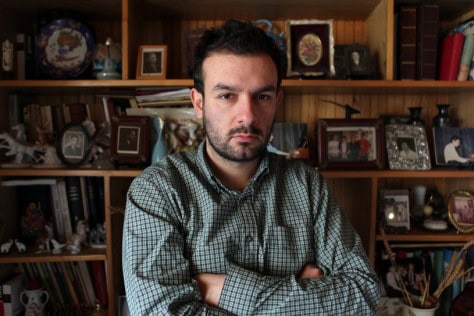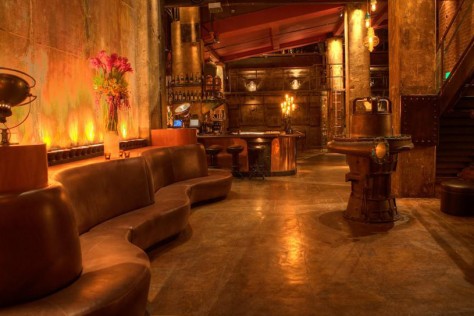Artist Ryan Wallace is back in school―the Brooklyn painter’s studio used to be a Catholic school and he shares a school room with fellow artist Keegan McHargue. The cavernous sunny room is starkly white and streaming with light, and it quickly warms up as Wallace ambles around the room, gently sifting through his gigantic canvases and collages.
There are a million struggling artists in Brooklyn, a million painters and sculptors and printmakers. But Ryan Wallace, 32, might just be a little bit different. After all, there are few artists whose work so intently references the startling magic of scientific discovery, the cross-pollination of creativity and technology. And the Large Hadron Collider.
The collider, as its explained by Morgan Lehman gallery, which plays host to Wallace’s newest solo show, “Glean,” this month in New York, is aiming to “find the 'God Particle,' reveal the scaffolding of the cosmos, explain the Big Bang―and threatens to engulf the universe.”
No biggie.
“I'm reading a lot about technology and futurism and science,” Wallace explains during a recent studio visit, “and I use a lot of cues to hint at that.”
But that doesn't mean that Wallace's work exists in an inaccessible abstract art bubble. “If the only entry point with abstract work is 'abstract work' then you have a smaller audience. I want my work to speak to a broader group of people.”
Yeah, but the Hadron Collider?
“These are new technological developments, but the questions that they pose are the oldest questions ever—they're nothing new,” continues Wallace. “At the root of it, these are Stone Age things. These questions consistently repeat themselves. It's stuff that art has addressed since the very beginning.”

And it's the power of these themes—and Wallace's deft ability to communicate them, to turn them from concept to canvas – that make his work so compelling. Collaged canvases feature deftly arranged strips of colored paper in a deep and beautiful vortex—some nearly faded to nothingness. Paintings present otherworldly geometric scapes and textures.
Jay Lehman, owner and curator of Morgan Lehman Gallery says that it's not just the theoretical underpinnings of Wallace's work that are so striking, but also his technical savvy. “The work has both artists and non-artists asking—how did he make that?—the surface is so matte yet luminous. Is it encaustic? Is it resin? Collage? Paint? All of the above? How does he achieve the depth of field?”
“Painting kind of came naturally,” says Wallace, who studied fine arts at the Rhode Island School of Design. “When I learned how to manipulate paint I could understand that pretty well. I learned things like composition and color theory, which is what my stuff is rooted in.”
His newer collages pieces, in muted tones, a minimal palette, and with layers of polyvinyl acetate, came out of his painting. “When I'm working on paintings, I'll tape areas off and pieces of paper. The collages wouldn't have happened if I wasn't making the oil paintings.”

Wallace cites former studio mate Joey Hart as a major influence with his collage work. “It's just a nice way to work. It's a nice low-pressure kind of practice. I can do things on paper that don't work in paintings. Things can float around and get dirty. [Collages] rely on my hand making those marks. There is an arbitrariness—even though it appears really controlled. It's like chemistry—I don't know what it's going to look like, it's the chemistry of the glue and the mylar and the paper.”
Like glue to mylar and paper, Wallace is equally drawn to collaboration and community. Wallace recently contributed to longtime friend Chris Duncan's artist 'zine project Hot and Cold. In turn, Duncan participated in a show Wallace curated at Los Angeles' Raid Projects, themed around exploring specific systems of taxonomy. The show, titled “Default State Network,” features work by Duncan, Hart, Glen Baldridge, Elise Ferguson and others, is a meditation on the evolution of systems, from the primitive to the highly advanced.
Artist Alex Dodge, who is also featured in the Raid Projects show, and has known Wallace since his days as a student at RISD, says that Wallace's fascination with taxonomy extends into his own work. “Ryan's work is something of a phenomenological investigation informed by a sincere interest in science and theory.”
“Ryan has a distinct, distilled system of picture-making which I am drawn to,” says Ryan Callis, assistant curator of the Torrance Art Museum, and a long time supporter of Wallace's work. “It derives from system-based abstraction, which is how I work as well. I also really enjoy his implied search for deeper consciousness through his process and pictures—a la Agnes Martin or Richard Tuttle.”
“I think that most young artists these days make versions of what they think art should look like,” he continues, “while Ryan makes work that he thinks should operate in the way he thinks it should operate.”
And at its core, despite its roots in abstraction, Wallace's work is incredibly human, organic and emotional. “Initially there is a kind of pristine grittiness. It has the rugged smudged evidence of its process and material nature, a process that can seem a crude give and take,” says Dodge. “His works attempt to describe things that seem larger than human; the mysteries of the universe, the origins of consciousness. Maybe it's that grittiness, those thumb prints here and there that remind us how human those things are.”
“Glean” at Morgan Lehman Gallery, February 11 – March 20, New York, NY
“Default State Network” group show at Raid Projects, February 6 – 27, Los Angels, CA
 Q&A with Larry Gus
Q&A with Larry Gus We Own the Night: The Edison
We Own the Night: The Edison
No Comments